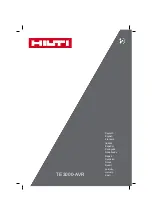
5. Monitoring, warning, error, repair
page 33
ELC PE22B-PE35B V1.0-05.19-GB
Subject to technical alterations
5.4.2.
Error description and trouble shooting
The following table gives a connection between bit-names in the [Error Register] and the most
common causes for an error and possible corrective actions. A more detailed trouble shooting
list is available on demand.
Bit set in
Error
register
Description
{Bit-name in error register}
Detection
only in lamp
operation
Corrective action
Bit 0
(0x0001)
{DC-Link-Undervoltage}
: internal dc
link voltage is low due to low mains
voltage, blown internal fuses or other
defective parts inside the ELC.
Yes
Check mains voltage
Consider charge time
Bit 1
(0x0002)
{Mains Voltage Low}
: not in use with
this ballast type.
-
-
Bit 2
(0x0004)
(
not available): bit reserved for future
applications.
-
-
Bit 3
(0x0008)
{ELC Temperature High}:
internal
temperature too high.
No
Check ambient temperature and
fans of cabinet (direction of air
current, change filter mats).
Bit 4
(0x0010)
{Internal}
:
bit for analysis by the
manufacturer.
No
-
Bit 5
(0x0020)
{Bus Connection Error}
: bus
connection fails during lamp
operation. Additionally the green
Status-LED (see Fig. 7) is blinking, or
completely off as soon as the internal
communication of the ELC is
interrupted.
Yes
Check bus termination and
connector contact.
Bit 6
(0x0040)
{Overvoltage}
: short peak overvoltage
on the lamp exceeds nominal ignition
voltage during ignition or operation
due to an internal problem of the ELC
or damaged cables on lamp circuitry.
Yes
Check lamp wiring concerning
insulation defects.
Bit 7
(0x0080)
{Lamp Voltage High}
: the lamp
voltage exceeds a threshold critical for
the ELC. Usually the lamp type is not
correct.
Yes
Check lamp type and lamp
connectors/sockets, switch lamp.
Bit 8
(0x0100)
{Overcurrent}
: lamp overcurrent.
Yes
Check for short in lamp circuit.
Bit 9
(0x0200)
{Measurement}
: problems with the
internal measurement circuits.
Yes
Check for short in lamp circuit.






































